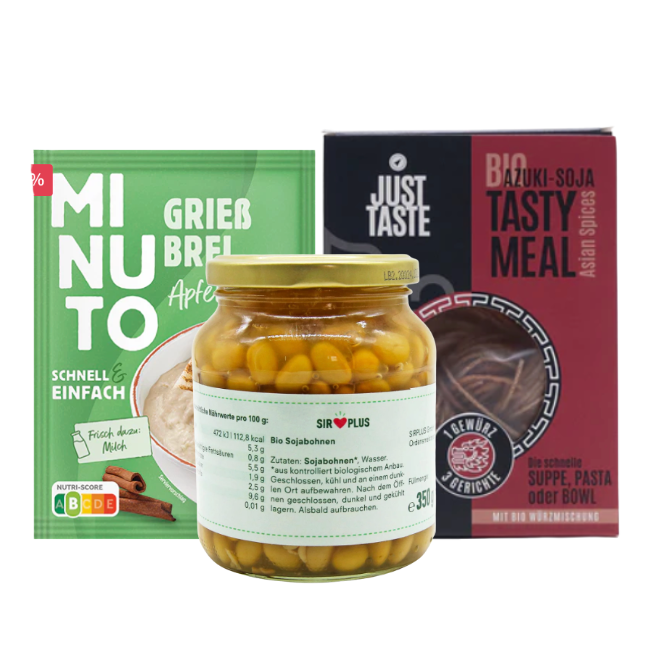What exactly does "best before" date mean for pasta ? Here you'll learn how long pasta really lasts and how to store it optimally.
The most important information at a glance
-
The best before date (BBD) on pasta is a guideline and practically never means that the pasta is immediately inedible after this date.
-
The shelf life of pasta depends on its type and the storage conditions; conventional, dry pasta can often remain edible for years after the best-before date .
-
Proper storage in airtight containers in a cool, dark place maximizes shelf life and helps reduce food waste.
Understanding the best-before date (BBD) of pasta
The best-before date (BBD) on pasta is an important guideline indicating the date until which manufacturers guarantee that the pasta will retain its typical characteristics, such as taste and smell. However, it is a common misconception that pasta becomes inedible immediately after the BBD has passed .
In fact, most pasta is still perfectly edible long after the best-before date, as long as there are no signs of spoilage. The best-before date serves more as a guideline than a strict expiration date. An expired best-before date doesn't automatically mean the food has gone bad, but simply that it may no longer be of optimal quality.
Understanding the best-before date (BBD) can not only save you money but also make an important contribution to reducing food waste . Many foods that have passed their BBD are still perfectly fine and shouldn't be thrown away immediately. This helps avoid unnecessary waste and conserve resources.
How long do noodles really keep?
How long pasta actually keeps depends on the type of pasta and the storage conditions. Conventional, uncooked pasta without eggs is so dry that it can still be edible for many years after the best-before date if stored correctly. Whole-wheat pasta and egg noodles, on the other hand, have a shorter shelf life of about a year because they contain more fat, which can go rancid more quickly.
The best-before date is not an expiration date. Many pasta products are still edible after the best-before date has passed, as long as they show no signs of spoilage. While an expired best-before date may indicate a possible loss of quality, it does not mean the pasta is inedible.
Uncooked, dry pasta can even be stored for years if stored correctly.
Optimal storage of pasta
Proper storage of pasta is crucial for extending its shelf life. Pasta should be stored in a cool, dry, and airtight container. Optimal storage prevents the pasta from absorbing moisture and thus spoiling more quickly.
There are several tried-and-tested methods to ensure your pasta stays fresh for as long as possible. These include using airtight containers and storing it in a dark, cool place. We'll explain these methods in more detail in the following sections.
Use airtight containers
Airtight containers are ideal for protecting fusilli from moisture and air, which can impair their shelf life. Using such containers helps maintain the quality of the pasta for longer, as it is shielded from external influences.
Make sure the containers are clean and dry before adding the pasta. This will help keep the pasta fresh and edible until you're ready to use it.
Store in a dark and cool place
Besides using airtight containers, it's important to store pasta in a cool, dark place. You should keep the following points in mind:
-
Avoid heat and light, as they can impair the quality of the pasta and increase the risk of mold and spoilage.
-
A pantry or larder is ideal. The cupboard should be away from heat sources such as the stove or windows to avoid unfavorable temperatures.
By storing pasta properly, you can ensure that it retains its freshness and quality for a longer period. This is especially important for long-term storage and helps to avoid food waste.
Can pasta go bad?
Although pasta has a long shelf life , it can spoil under certain conditions. A rancid smell is a clear sign that the pasta is spoiled, possibly due to grease deterioration or pest infestation. Visible mold or pests are also clear indicators that the pasta is no longer edible.
Discoloration or dark spots on the pasta also indicate that it is spoiled. If pasta smells normal and shows no changes in color or texture, it is usually still safe to eat, even if the best-before date has passed. Salt can help improve the taste of the pasta.
When in doubt, always throw away spoiled food to avoid health risks. However, food that has been stored correctly after its best-before date and smells and tastes unchanged can often still be consumed, as permitted by law, except under certain conditions. Ultimately, it's important to pay attention to the quality of food and its edibility.
Comparison with other dry products
Pasta is often compared to other dry goods such as rice, flour, and legumes. White pasta and rice have a similar shelf life and, if stored properly, can remain edible for many years beyond their best-before date. Brown rice, on the other hand, has a shorter shelf life of about one year due to its higher fat content.
Flours like types 405 and 550 can be stored for several months beyond their best-before date, while whole-grain flours, due to their higher fat content, only last 4 to 6 months. This again demonstrates that fat content has a significant impact on shelf life.
Legumes such as dried peas, beans, and lentils generally have a shelf life of 1 to 2 years, depending on storage conditions. These products have similar storage requirements to pasta and should also be kept in a cool, dry place to maximize their shelf life.
Freezing pasta: An alternative way to extend its shelf life
Freezing pasta is an effective way to extend its shelf life and reduce food waste. Cooked pasta can be stored in the refrigerator for up to five days, but should be kept in airtight containers before freezing.
To maintain the quality of frozen pasta, it is important to use suitable containers. This prevents the pasta from developing freezer burn and losing its texture and flavor.
Freezing pasta ensures you always have a portion on hand without having to worry about expiration dates. This is especially useful for meal planning and preventing food waste.
Avoid food waste
Food waste is a major problem that we can all combat. Good meal planning and introducing a "leftovers day" each week can help significantly reduce waste. This means consciously using leftovers and creatively integrating them into your plans. Additionally, recommendations for reducing food waste can be helpful.
Proper food storage plays a crucial role in maximizing shelf life and preventing waste. By storing pasta and other dry goods correctly, you can ensure they stay fresh longer and don't end up in the trash unnecessarily.
It's also important to be aware that the "best before" date is not a strict expiration date. Many foods are still edible after the "best before" date has passed, as long as they show no signs of spoilage. This helps conserve resources and reduce environmental impact, as recommended by consumer protection agencies.
Summary
In summary, understanding the best-before date and storing pasta correctly are crucial to maximizing its shelf life and avoiding food waste. Pasta can often remain edible long after the best-before date if stored properly.
By being more mindful of our food and using proper storage methods, we can not only save money but also make an important contribution to sustainability. Let's work together to reduce food waste and conserve our resources.
Frequently Asked Questions
What is the difference between the best before date and the use-by date?
The main difference is that the best before date indicates the shelf life of a product's typical characteristics, while the use-by date defines a clear time frame for safe consumption, as the product may become harmful to health after this date.
Do noodles have to be thrown away immediately after the best-before date has passed?
Pasta doesn't need to be thrown away immediately after the best-before date, as long as it shows no signs of spoilage. It's advisable to check its appearance and smell before eating it.
How can I ensure that my pasta stays fresh for a long time?
To maximize the shelf life of your pasta, store it in a cool, dry place in an airtight container. This will keep it fresh and edible for longer.
Can fresh pasta be frozen?
Yes, freezing fresh pasta is an effective way to extend its shelf life and minimize food waste. It's recommended to freeze it in portions.



